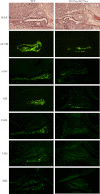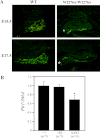Developmental analysis and influence of genetic background on the Lhx3 W227ter mouse model of combined pituitary hormone deficiency disease
- PMID: 23288907
- PMCID: PMC3548188
- DOI: 10.1210/en.2012-1790
Developmental analysis and influence of genetic background on the Lhx3 W227ter mouse model of combined pituitary hormone deficiency disease
Abstract
Combined pituitary hormone deficiency (CPHD) diseases result in severe outcomes for patients including short stature, developmental delays, and reproductive deficiencies. Little is known about their etiology, especially the developmental profiles and the influences of genetic background on disease progression. Animal models for CPHD provide valuable tools to investigate disease mechanisms and inform diagnostic and treatment protocols. Here we examined hormone production during pituitary development and the influence of genetic background on phenotypic severity in the Lhx3(W227ter/W227ter) mouse model. Lhx3(W227ter/W227ter) embryos have deficiencies of ACTH, α-glycoprotein subunit, GH, PRL, TSHβ, and LHβ during prenatal development. Furthermore, mutant mice have significant reduction in the critical pituitary transcriptional activator-1 (PIT1). Through breeding, the Lhx3(W227ter/W227ter) genotype was placed onto the 129/Sv and C57BL/6 backgrounds. Intriguingly, the genetic background significantly affected viability: whereas Lhx3(W227ter/W227ter) animals were found in the expected frequencies in C57BL/6, homozygous animals were not viable in the 129/Sv genetic environment. The hormone marker and PIT1 reductions observed in Lhx3(W227ter/W227ter) mice on a mixed background were also seen in the separate strains but in some cases were more severe in 129/Sv. To further characterize the molecular changes in diseased mice, we conducted a quantitative proteomic analysis of pituitary proteins. This showed significantly lower levels of PRL, pro-opiomelanocortin (ACTH), and α-glycoprotein subunit proteins in Lhx3(W227ter/W227ter) mice. Together, these data show that hormone deficiency disease is apparent in early prenatal stages in this CPHD model system. Furthermore, as is noted in human disease, genetic background significantly impacts the phenotypic outcome of these monogenic endocrine diseases.
Figures






Similar articles
-
Model of pediatric pituitary hormone deficiency separates the endocrine and neural functions of the LHX3 transcription factor in vivo.Proc Natl Acad Sci U S A. 2011 Jan 4;108(1):173-8. doi: 10.1073/pnas.1009501108. Epub 2010 Dec 13. Proc Natl Acad Sci U S A. 2011. PMID: 21149718 Free PMC article.
-
A recessive mutation resulting in a disabling amino acid substitution (T194R) in the LHX3 homeodomain causes combined pituitary hormone deficiency.Horm Res Paediatr. 2012;77(1):41-51. doi: 10.1159/000335929. Epub 2012 Jan 26. Horm Res Paediatr. 2012. PMID: 22286346 Free PMC article.
-
Molecular analysis of LHX3 and PROP-1 in pituitary hormone deficiency patients with posterior pituitary ectopia.J Clin Endocrinol Metab. 2000 Aug;85(8):2701-8. doi: 10.1210/jcem.85.8.6706. J Clin Endocrinol Metab. 2000. PMID: 10946868
-
[Congenital hypopituitarism: when should transcription factor gene screenings be performed?].Presse Med. 2004 Mar 27;33(6):400-5. doi: 10.1016/s0755-4982(04)98607-1. Presse Med. 2004. PMID: 15105786 Review. French.
-
A novel mutation of LHX3 is associated with combined pituitary hormone deficiency including ACTH deficiency, sensorineural hearing loss, and short neck-a case report and review of the literature.Eur J Pediatr. 2011 Aug;170(8):1017-21. doi: 10.1007/s00431-011-1393-x. Epub 2011 Jan 20. Eur J Pediatr. 2011. PMID: 21249393 Review.
Cited by
-
Bioinformatic Analysis of Differential Protein Expression in Calu-3 Cells Exposed to Carbon Nanotubes.Proteomes. 2013 Oct 14;1(3):219-239. doi: 10.3390/proteomes1030219. Proteomes. 2013. PMID: 25177543 Free PMC article.
-
Cell-specific actions of a human LHX3 gene enhancer during pituitary and spinal cord development.Mol Endocrinol. 2013 Dec;27(12):2013-27. doi: 10.1210/me.2013-1161. Epub 2013 Oct 7. Mol Endocrinol. 2013. PMID: 24100213 Free PMC article.
-
Multi-omic profiling of pituitary thyrotropic cells and progenitors.BMC Biol. 2021 Apr 15;19(1):76. doi: 10.1186/s12915-021-01009-0. BMC Biol. 2021. PMID: 33858413 Free PMC article.
-
LHX3 interacts with inhibitor of histone acetyltransferase complex subunits LANP and TAF-1β to modulate pituitary gene regulation.PLoS One. 2013 Jul 4;8(7):e68898. doi: 10.1371/journal.pone.0068898. Print 2013. PLoS One. 2013. PMID: 23861948 Free PMC article.
-
Issues and applications in label-free quantitative mass spectrometry.Int J Proteomics. 2013;2013:756039. doi: 10.1155/2013/756039. Epub 2013 Jan 16. Int J Proteomics. 2013. PMID: 23401775 Free PMC article.
References
-
- Mollard P, Hodson DJ, Lafont C, Rizzoti K, Drouin J. A tridimensional view of pituitary development and function. Trends Endocrinol Metab. 2012;23:261–269 - PubMed
-
- Prince KL, Walvoord EC, Rhodes SJ. The role of homeodomain transcription factors in heritable pituitary disease. Nat Rev Endocrinol. 2011;7:727–737 - PubMed
-
- Sharma K, Sheng HZ, Lettieri K, et al. LIM homeodomain factors Lhx3 and Lhx4 assign subtype identities for motor neurons. Cell. 1998;95:817–828 - PubMed
Publication types
MeSH terms
Substances
Grants and funding
LinkOut - more resources
Full Text Sources
Other Literature Sources
Molecular Biology Databases

